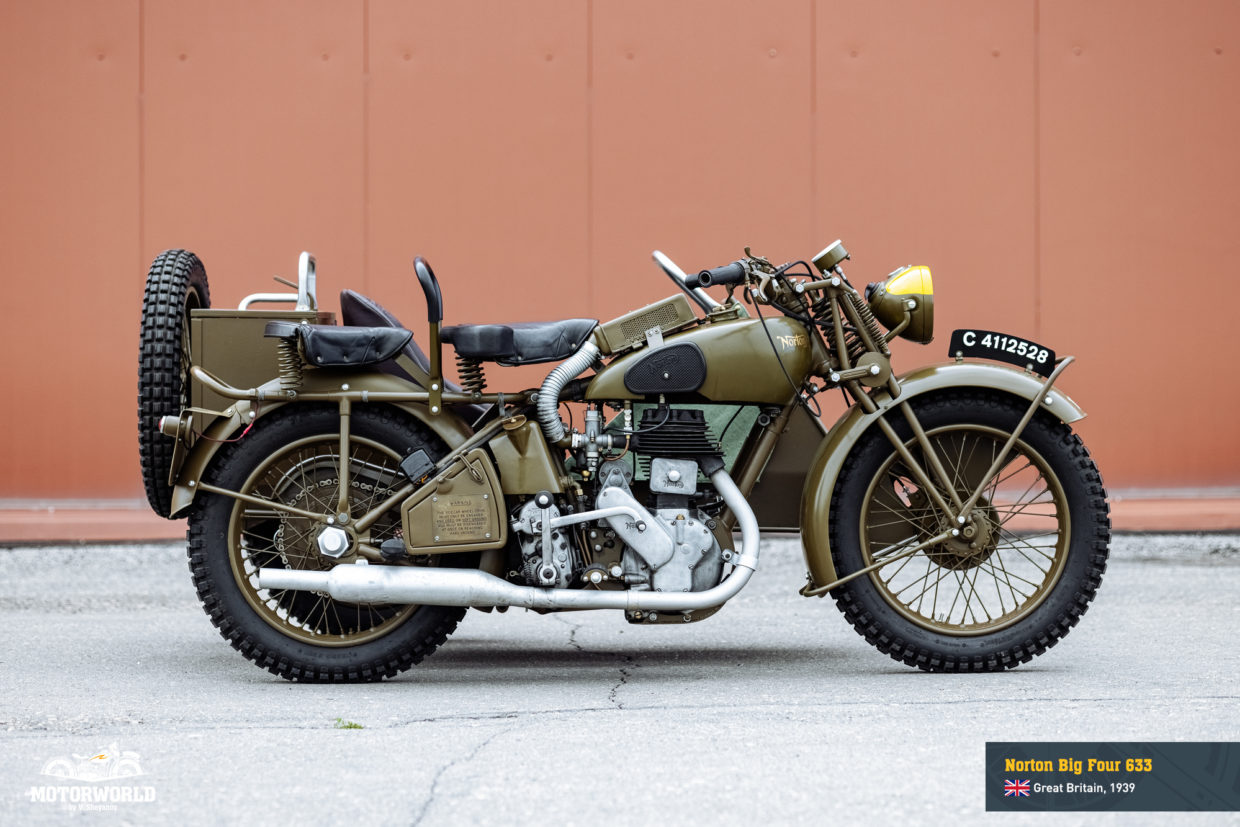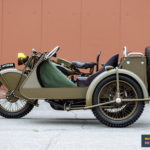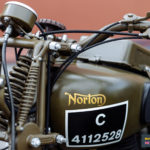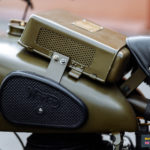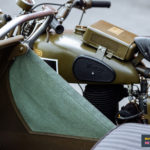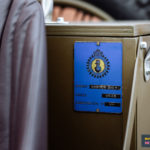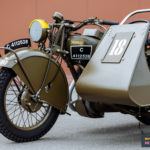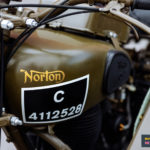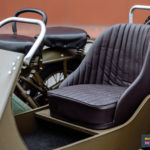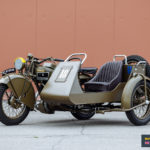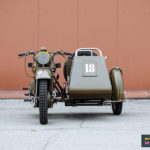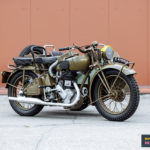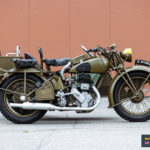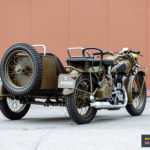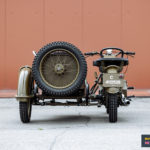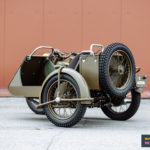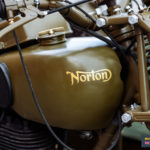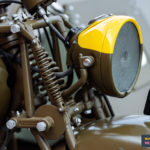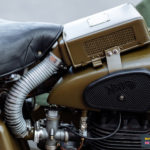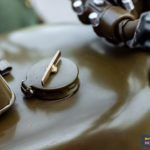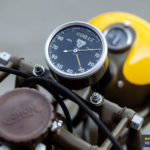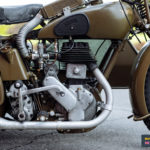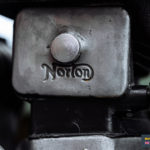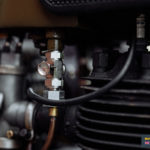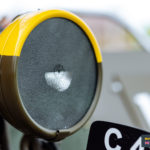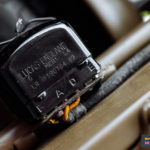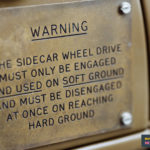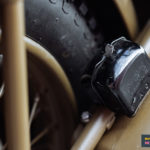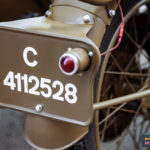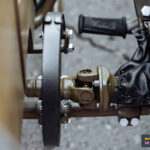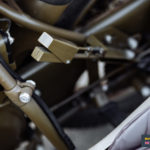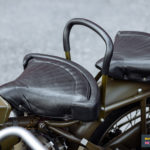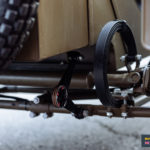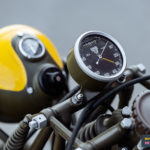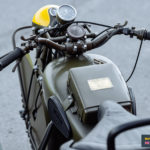This entry is also available in: Russian Chinese (Traditional)
Motorworld’s newspaper № 6
In 1898 in Birmingham, James Lansdown Norton founded the Norton Manufacturing Company as a manufacturer of fittings and parts for motorcycles. By 1902 the first Norton Energette motorcycles were being produced using 150cc engines.
In 1909, Norton released its most famous and ‘long-lasting’ motorcycle – Norton Model 1, or more commonly known as Big 4. The motorcycle was designed for use with a sidecar and from 1909 to 1954 there were various modifications to the design.
James Norton was a great engineer but struggled with the business, so his company went into bankruptcy in 1912 and was bought by Bob Shelley, the owner of the R.T. Shelley & Co. company, who saw the potential in Norton motorcycles and even kept James as one of the directors and a chief designer.
In the late 1910s and early 1920s, Norton constantly complained about his health, although he was only in his 50s. During the winter of 1921-1922, Norton decided to visit his brother in Durban, South Africa, going there on his favorite Norton Big Four 633.
James had hoped that this journey would improve his health and show the strength of a human spirit and the capabilities of the machine he had created. And it just so happens that it was a particularly severe rain season in Africa at the time, and Norton had to cross rivers in flood and take many detours because numerous bridges had been swept away. It was a great reliability test trial for the Norton Big Four but overall successful. After he returned home, James had several ideas on how to refine the design of the bike.
In 1922, James Norton was diagnosed with terminal cancer. He died in 1925, however, his ideas are still alive.
By 1935 the British Army was finally disappointed in the use of the BSA 500cc OHV V-twins (BSA B15), which had been purchased a few years earlier, to replace the old Douglas and Triumph vehicles.
Eight British manufacturers had to present their machine for testing, with the BSA motorcycle used as a preferred example.
The Norton 16H was first offered for military evaluation in 1935. It had high-clearance, all-terrain tires, trunk, speedometer, electric signal, and was painted in khaki colors. The motorcycles from such manufacturers as Royal Enfield, Matchless, and Triumph have also been tested. Finally, the Army report summarized that all machines submitted for evaluation were superior to BSA, however, the Norton was the best of them all.
In early 1936, the Department of Army Civilian (DAC) refined its specifications, and Norton company got a contract to supply 300 vehicles, along with spare engines and frames. The work began in February and was completed by mid March. That same year, the company received two more contracts, and by the end of 1936, another 900 copies of the 16H Model had been delivered to the Army.
By 1936, the growing threat caused by Nazi Germany was finally recognized by the authorities, and a wave of rearmament spread all over the country. During 1937 Norton was contracted to supply another 2000 vehicles to the army. Since 1936, there have been few updates in the motorcycle design, the main change was the introduction of the relay controller.
At the beginning of 1938, the Department of Army Civilian ordered 15 motorcycles with sidecar wheel drive (SWD) for further testing. Apparently, this idea came to British officials after they realized the advantage of German BMW and Zundapp with sidecar wheel drive.
This very scheme of the drive applied to Norton Big 4 was first used by the company Baughan in 1929. The founder of the company, Henry Baughan, offered his all-wheel drive system (which proved to be successful in cross-country racing) to the military back in 1932, but his idea was rejected. Fortunately for Norton, Henry Baughan never patented his invention, so the company did not have to pay royalties for the use of his technology.
The first Norton Big 4 (SWD) was completed in May 1938, while the other 14 were completed in August 1938 with minor design changes. Another 315 copies were produced in May 1939, and in November the company got more significant military orders.
Since the civilian Big 4 never had a sidecar wheel drive, constructive changes in the frame were required. Today, these changes allow restorers to easily reconstruct the military past of the motorcycle. The front end, including the steering head and top of the frame, was similar to the pre-war models, but in this variation, the fastening bracket for chain protection and cam clutch lever for sidecar wheel drive were added to the rear left side. Also, the castings holding bearings of the rear wheel axle were reinforced and modified.
In general, Norton engineers have combined all the improvements in two revisions, and even if some of the modifications could be seen on random military Norton Big 4 of different years of production, it was because of the untimely modernization, not the negligence of the designers.
The first version (1938 – early 1940):
– Basic civilian version (including frame modifications) with rubber handlebar grips and rubberized civilian footrests;
– The rear license plate and the rear light mounted in the upper right corner of the plate are both of the civil type (Lucas MT110);
– Front plates with a Census-number. Today, these numbers, along with the engine and frame numbers, allow us to establish the contract number, under which the motorcycle was delivered to the British Army;
– Toolbox with a school-type lock;
– Oil tank with a welded seam at the back;
– Smiths 80-mile speedometer with no daily odometer mounted in the middle of the fork;
– 1-inch handlebars (0.75 inch bars on civilian versions);
– Seven-inch headlight (Lucas DU42) painted in khaki colors. Due to the lack of well-established production of black-out masks, the first versions were equipped with a mask made of Manila paper and installed inside the headlight;
– Forward-facing horn (Lucas HF1234);
– The screw of the cover, that closes access to the pusher bars, with a round ribbed head.
The second version (1940-1945):
– The wing-type lock on the toolbox;
– Steel footrests;
– Speedometer installed on the left side of the fork;
– Small changes in appearance (including the absence of chrome parts).
The wheels were covered with 4.00 x 18 tires. With the motorcycle’s weight of more than 400 kg, it was impractical to use the usual racks for replacement of wheels, so there was a car jack Austin 7 (manufactured by R.T. Shelley & Co.) located in the trunk of the sidecar.
The Norton had the list of orders on military equipment, which in early 1939 included about 600 copies of 16H Model and 315 units of Big 4. Also, 300 copies of 16H had to be made for the Ministry of Aviation, 50 copies of 16H were ordered from India and several smaller orders for other colony governments were awaiting their turn.
Pretty unexpected news was when Norton announced its withdrawal from the 1939 racing season in favour of focusing on improving production capacity for military motorcycles. The announcement was met with anxiety, with many saying that Norton had refused to participate because it could not compete with foreign ‘superior’ motorcycles. Only some people understood that war was inevitable, and Norton’s decision was more than rational in the current situation.
The Department of Army Civilian ordered another 1600 units of 16H (1936/37 specification). One month prior to the war, only a few civilian vehicles were produced. During the last week of August, 150 vehicles were assembled, mostly military ones. Civilian production ceased with the beginning of the war, on September 1, 1939, and by the end of October, the Norton already produced 300 military vehicles every week.
By 1940, the factory produced more than 400 motorcycles per week, thanks to huge orders from the Ministry of Defense, and eventually, this figure rose to a maximum of 500 units. At the end, the decision to stop participating in sports events was fully justified by the production achievements.
Starting from November 1939, a special numbering system was introduced for Big 4 (SWD) motorcycles, starting with the engine and frame number S1000 (the numbers were identical). The last Big 4 (SWD) with number S5308 left the factory in autumn 1941. Most of the military vehicles went to the British Army, but a significant number remained in the British Royal Air Force (RAF) and the armies of the colonies.
Due to the fact that the military motorcycles were repaired in military workshops, very few vehicles retained identical engine and frame numbers. The workers, who re-assembled the bikes at the factory lines, took spare parts from a number of containers and never cared about comparing the numbers. On top of that, the gradual modernization of motorcycles led to the fact that most of the pre-war machines did not retain their original appearance.
From 1938 to the autumn of 1941, approximately 4,779 Norton Big 4 (SWD) were produced under at least 10 contracts. Ten machines without sidecar wheel drive were manufactured for the RAF.
After the war, many military motorcycles were sold to the armies of other countries. They were also used as payment for the use of military bases, or even went to the civilian market, due to the high demand for any civil transport. The armies of such countries as Belgium, Norway, the Netherlands, and Greece used the WD16H Norton from the first postwar years until the late 50s.
At the end of August 1945, after the completion of military contracts, Norton returned to the production of the civilian 16H Model (1939 specification). In 1947, the production of civilian Norton Big 4 and ES2 was added to the production program.
With the appearance of the Roadholder telescopic front fork in 1947, the mentioned above models received the last visual modification. The final year of production of 16H and Big 4 was 1954.
Thanks to the contribution of motorcycle enthusiasts, such as Alex Smittens, Rob Miller, and many others, who have collected a stunning amount of information dedicated to the military Norton WD16H and WD Big 4 (https://www.wdnorton.nl/), we can now put together a detailed story about Norton WD Big 4 633 from the “Motorworld by V. Sheyanov” collection.
Having the original numbers of the frame and engine (S1270), we could figure out the year of manufacture (1939) and the contract under which the motorcycle was delivered to the British Armed Forces. The motorcycles were produced in quantities of 15-20 units per week, and deliveries were made on three dates: 28.08.1939, 02.11.1939, and 25.03.1940. The Norton Big 4 633cc, described in the article, was released in late 1939 – early 1940.
The Norton Big 4 motorcycles of that period went straight to the British Expeditionary Force (BEF), based in France from September 2, 1939 to May 31, 1940.
The participation of the British Expeditionary Corps in the French Campaign ended with Operation Dynamo, during which 338,226 allied soldiers were evacuated from the French coast. Among the weapons left in the enemy’s territory were 20 thousand motorcycles, including the Norton Big 4 from our collection.
This fact is supported by a large number of archival photographs, where you can see the serial numbers of motorcycles preceding and exceeding the S1270 number. The motorcycle has been restored following all the specifics of the production of that time and fully corresponds to the year of manufacture and its intended purpose.
Based on an article by Peter Roydhouse (https://www.wdnorton.nl/) and personal correspondence with Alex Smittens.
| Manufacturer | Norton Motors Ltd., Birmingham (Great Britain) |
| Years of manufacture | 1938 – 1945 |
| Quantity produced, units | 4 737 |
| Price | 162 £ |
| Today’s value | 10 549,8 $ |
| ENGINE AND TRANSMISSION | |
| Type | 1-cylinder, L-head |
| Engine capacity, cc | 633 |
| Bore and stroke, mm | 82 х 120 |
| Engine rating | 14.5 h.p. at 4000 rpm |
| Sparking | Magneto, right-side kickstarter arrangement |
| Carburetor | Amal 276 |
| Battery | 6 V |
| Clutch | Multiple-plate, oil-bath |
| Transmission | 4-speed |
| FRAME AND WHEELBASE | |
| Frame type | Tubular |
| Front suspension | Parallelogram, with frictional damper |
| Rear suspension | Rigid |
| Brakes | Drum type |
| Wheel size | 4,00 х 18 (3 wheels) |
| DIMENSIONS | |
| Length, mm |
2 184
|
| Width, mm |
1 689
|
| Height, mm |
1 168
|
| Wheelbase, mm |
1 371
|
| Ground clearance, mm |
127
|
| Seat height, mm |
820*
|
| Mass, kg |
308
|
| Gas tank size, l |
14
|
| Maximum speed, km/h |
90
|
| Range, km |
|

